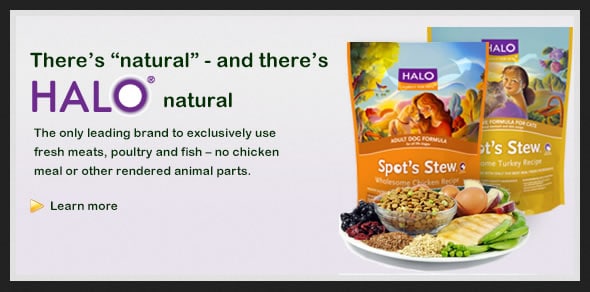
Halo, all natural kibble
What Does Crude Protein Really Mean in a Dry Dog Food?
The most popular blog I’ve ever written was about what “crude protein” really means — and whether the amount of crude protein in kibble is a reliable way to judge the best dog food for your own pooch. So I want to tell people who may not know it that I think the words “crude protein” should have a blinking caution light on dog food labels because these two words can be misleading. If there is a high percentage of crude protein on a dog food label we might assume it indicates high quality protein, and top notch food — but if we really understood what those two words mean, we would think about it differently when choosing a dog food for our tail-wagging family members.
Protein is the most expensive ingredient in any food, whether for pets or people. Protein — especially good quality protein from muscle meat — is the most costly part of a meal and therefore, savvy pet owners have learned to seek out high protein pet foods, believing those foods are the best. But there is a huge difference in where that protein comes from! To me, the most significant advantage Halo has over other kibble is that they use meat in their recipes — real meat, the way they do in their canned foods — and they do not use any rendered products or meal to achieve their protein content. It’s the only kibble I will feed my own dogs as part of their daily meals.
It’s sort of logical for pet owners to believe that the percentage of crude protein on a label (as required by the regulatory body AAFCO) refers to how much animal protein there is in the food. Instead, “crude protein” is actually a chemical analysis of the food whereby the amount of nitrogen present is used to estimate the amount of protein in the food. While nitrogen does come from animal protein, it also comes from non-animal proteins like grains, as well as other non-protein nitrogen (NPN) sources. This obviously creates a gap between what you think you are buying and feeding your dog (especially thinking you are getting a food with a high percentage of animal protein) — and what has actually been used to determine that number. Keep in mind that the toxic melamine was added to pet food as a non-protein nitrogen source to increase the appearance of high protein content in those pet foods that were part of the nationwide recall. (Halo has never been recalled).
In addition, for many dry food manufacturers, “crude protein” includes carcasses and other waste from slaughtered animals, rendered into a “meal.” The word “meal” on a pet food bag may indicate the inclusion of such ingredients, along with meat not fit for people to eat. This certainly helps clean up the slaughterhouse floor without having to call the garbage company! Unfortunately, inferior protein meals can give a dog food a high percentage of crude protein — without being high in quality protein.
Since pet food can include a variety of questionable ingredients, and crude protein measurements always include non-animal protein, here are ways to find a dog food with high quality protein.
- Choose a food that lists real whole meat on the bag as the first ingredient — chicken, lamb, salmon, etc. — because then you are getting true quality protein, not ingredients used to increase the nitrogen levels (and thereby give a higher crude protein percentage).
- Seek out foods that use whole vegetables, whole grains and real fruits — all hallmarks of a higher quality nutrition source.
- Read the entire label and make sure you understand all of the ingredients. A pet food doesn’t need to have any mysterious words on the label — it should be plain as day.
- Call the pet food company and ask about their protein or any of the ingredients you have questions about. A company should have a well-trained customer service staff as well as a veterinarian or nutritionist that can answer your questions. (Halo promptly answers phone calls from interested customers.)
Personally, I choose Halo and I don’t have to worry! They oversee their ingredient sources and other environmental variables and I believe Halo kibble is a great foundation for the quality dry portion of any dog’s nutrition.
–Tracie Hotchner
[iframe src=”//www.facebook.com/plugins/follow.php?href=http%3A%2F%2Fwww.facebook.com%2Ftraciehotchner&width=600&height=21&colorscheme=light&layout=button_count&show_faces=false&appId=178828585527299″ scrolling=”no” frameborder=”0″ style=”border:none; overflow:hidden; width:600px; height:21px;” allowTransparency=”true”]

